In your hands you hold the complete guide to National Park of American Samoa, including how to get there, things to do, when to visit, and so much more.
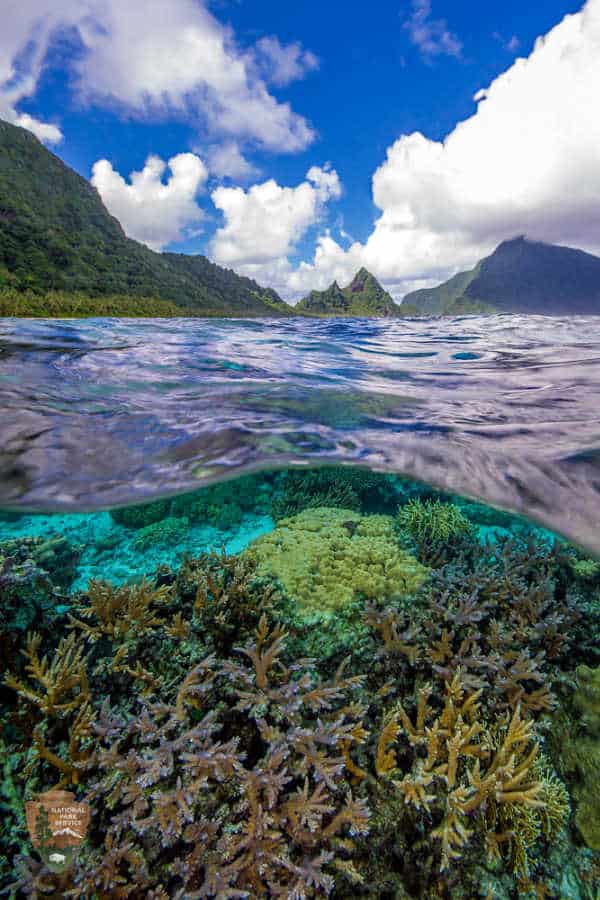
National Park of American Samoa
Visiting the NP of American Samoa is heading to the heart of the South Pacific to a world of sights, sounds, and experiences that you will find in no other National Park in the country.
About National Park of American Samoa
The NP of American Samoa is the only National Park Service site south of the Equator.
It sits about 5,000 miles from the U.S. mainland and 2,500 from Hawaii, making it unlike any other park in the system.
The park is spread across three different islands: Tutuila, Ta’u, and Ofu. The terrain is varied and unique, encompassing rugged cliffs, vibrant rainforests, soft sand beaches, and colorful coral reefs.
Is National Park of American Samoa worth visiting?
As the number one most far-flung national park, you have to REALLY want to cross this one off the bucket list to make the long journey to National Park of American Samoa.
That being said, it’s a park truly unlike any other, and those who visit this hidden gem will not regret it.
History of National Park of American Samoa
The Samoan Islands have been inhabited by the Samoan people for over 3,000 years, and their presence and cultural heritage live on to the present day.
However, in the 1800s, outside influence found its way to the island and ended up causing a battle over territory between Germany and the United States.
This stalemate ended when both parties lost most of their boats to a Tsunami. The area was then split, and in 1899 the U.S. seized the eastern portion of the islands, including ten volcanic islands (five of which are inhabited) and two coral atolls (one of which is inhabited).
It wasn’t until 1993 that parts of three islands (Tutuila, Ta’u, and Ofu) would become a national park.
It took about five years of discussion with the Samoan Chiefs, who hold the land dearly and were not keen on selling it off.
In the end, the Samoan people agreed to lease the land to the National Park Service for 50 years and continue to help maintain this incredible area.
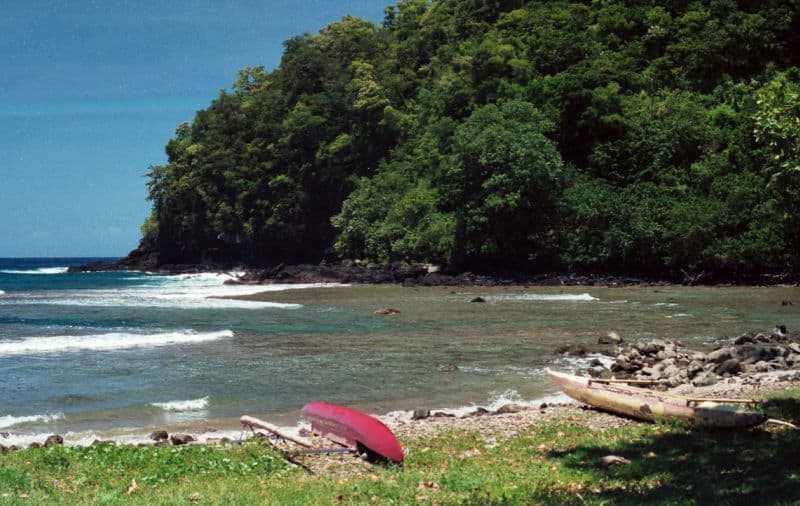
Credit - National Park Service
Things to know before your visit to the National Park of American Samoa
American Samoa National Park Entrance Fee
Park entrance fees are separate from camping and lodging fees.
American Samoa National Park does not charge an entrance fee!
Learn more about National Park Passes for parks that have an entrance fee.
$80.00 - For the America the Beautiful/National Park Pass. The pass covers entrance fees to all US National Park Sites and over 2,000 Federal Recreation Fee Sites for an entire year and covers everyone in the car for per-vehicle sites and up to 4 adults for per-person sites.

Buy your pass at this link, and REI will donate 10% of pass proceeds to the National Forest Foundation, National Park Foundation, and the U.S. Endowment for Forestry & Communities.
National Park Free Entrance Days -Mark your calendars with the free entrance days the National Park Service offers for US citizens and residents.
Time Zone
Samoa Standard Time
GMT-11
Pets
Pets are not allowed in public buildings, public transportation vehicles, swimming beaches, hiking trails or within park buildings and structures.
Cell Service
Cell service is going to depend on if you have an international service plan.
Park Hours
24-hours per day, year round
Wi-Fi
Public WiFi is available.
Food/Restaurants
There are no restaurants within the park.
Gas
There are no gas stations within the park.
Drones
Drones are not permitted within National Park Sites.
Don't forget to pack
Don't forget to Pack these Items
Insect repellent is always a great idea outdoors, especially around any body of water.
We use Permethrin Spray on our clothes before our park trips. Please read my article on preventing biting insects while enjoying the outdoors.
Sunscreen - I buy environmentally friendly sunscreen whenever possible because you inevitably pull it out at the beach.
Bring your water bottle and plenty of water with you. Plastic water bottles are not sold in the park.
Sunglasses - I always bring sunglasses with me. I personally love Goodr sunglasses because they are lightweight, durable, and have awesome National Park Designs from several National Parks like Joshua Tree, Yellowstone, Hawaii Volcanoes, Acadia, Denali, and more!
Click here to get your National Parks Edition of Goodr Sunglasses!
Binoculars/Spotting Scope - These will help spot birds and wildlife and make them easier to identify. We tend to see waterfowl in the distance, and they are always just a bit too far to identify them without binoculars.
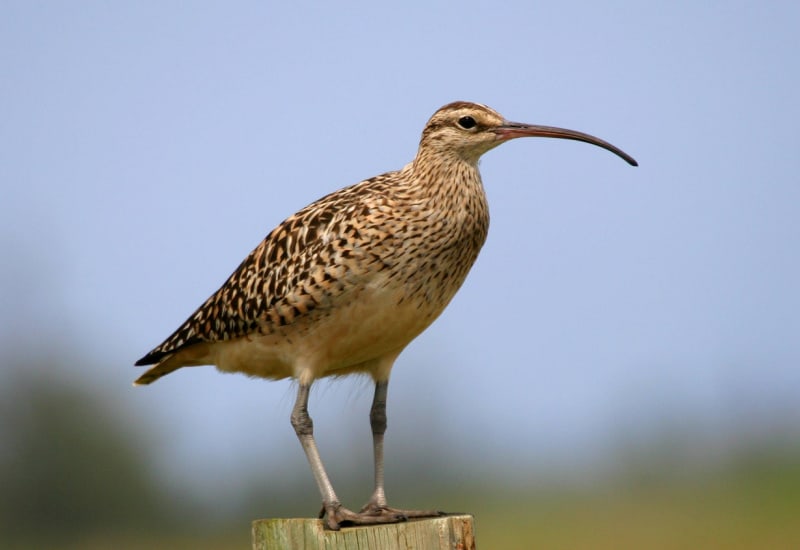
Credit - National Park Service
Details about National Park of American Samoa
Size - 8,256 acres
13,500 total acres - (9,500 land acres and 4,000 marine acres—mostly coral reefs).
American Samoa NP is currently ranked at 61 out of 63 National Parks by Size.
Date Established
October 31, 1988
Visitation
In 2021, NP of American Samoa had 8,495 park visitors.
In 2020, NP of American Samoa had 4,819 park visitors.
In 2019, NP of American Samoa had 60,006 park visitors.
Learn more about the most visited and least visited National Parks in the US
National Park Address
National Park of American Samoa
MHJ Building, 2nd Floor
Pago Pago, AS 96799
National Park Map
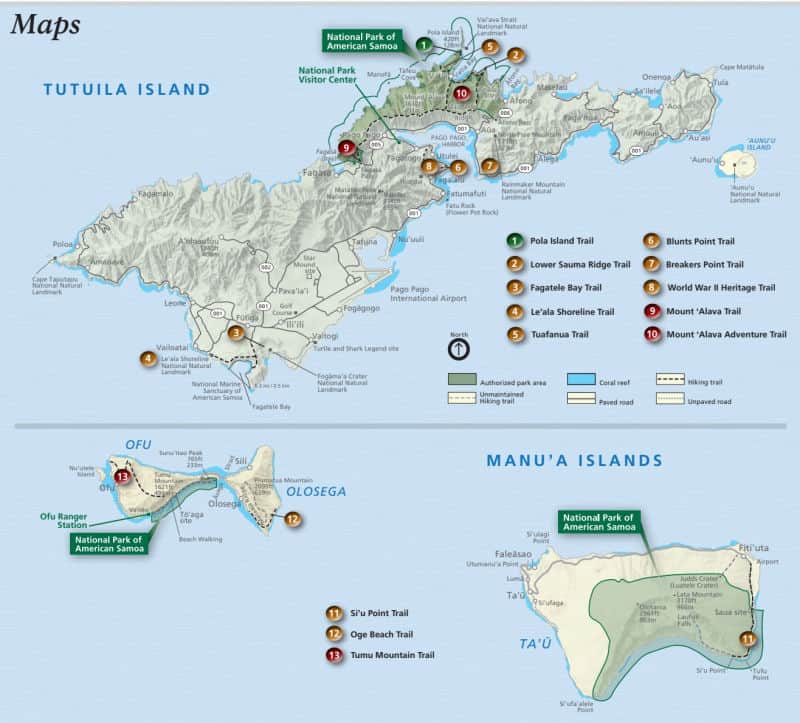
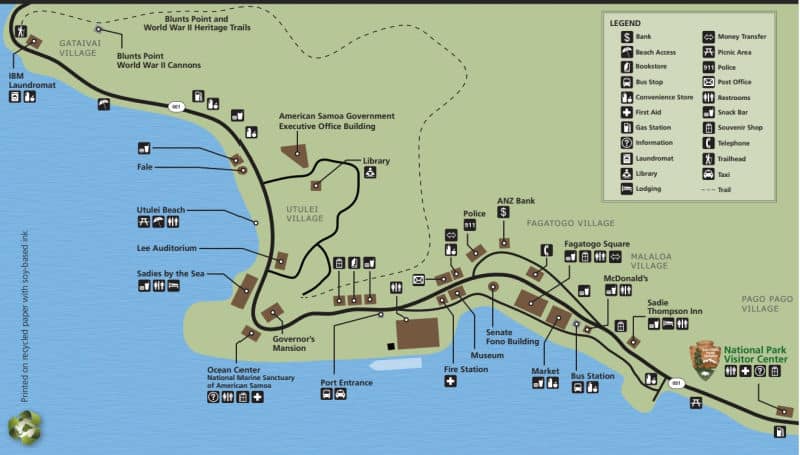
Where is National Park of American Samoa?
The park is 2,600 miles southwest of Hawai'i
The national park is located in the villages of Vatia, Pago Pago, Fagasa, Afono (on Tutuila Island), Fitiuta, Faleasao (on Ta'u Island), and Ofu Island.
Estimated Distance from nearby National Park
Each of these parks would need to be flown into. They are located in Hawaii and Alaska which are unique just like National Park of American Samoa.
Hawaii Volcanoes National Park
Where is the National Park Visitor Center?
Located in Pago Pago, across from the Pago Way Service Station.
Open on weekdays from 8:00 am to 4:30 pm. Closed on weekends and federal holidays
Getting to National Park of American Samoa
Closest Airports
Pago Pago International Airport on Tutuila Island.
Currently, Hawaiian Airlines is the only major carrier to American Samoa. They provide two flights a week round-trip from Honolulu, Hawai'i.
Car Rentals
Several car rental facilities are available near the Pago Pago International Airport.
Bus
There are two buses that travel to the national park. Look for a bus in the Pago Pago Village area with signage for Vatia.
Vatia Village is located within the national park. Be prepared to wait up to an hour for the bus.
Buses do not run on Sundays.
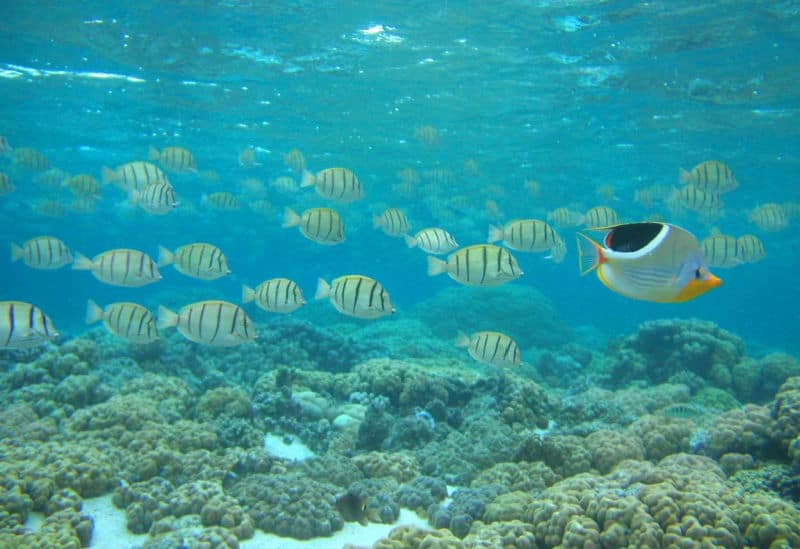
Credit - National Park Service
Best time to visit National Park of American Samoa
Thanks to its location near the equator, it’s possible to visit the park and enjoy warm weather year-round. That being said, rain and tropical storms are common, especially between October and May.
For dryer conditions, plan your trip between June and September.
Weather and Seasons
Spring
The first months of spring are generally wet. It’s also possible that a tropical storm can swoop in and put a damper on plans (or even shut down the entire park), so try to plan your trip for May at the earliest if possible.
Summer
Summer is a great time to visit National Park of American Samoa, as temperatures are slightly cooler and the weather is dryer.
Fall
Early fall is another good time to visit the park, as it’s still cool and dry until mid to late October.
By November, the full rainy season will have set it, so be prepared for wet conditions if you visit later in the season.
Whale watching is especially great during the fall, specifically between August and November.
Winter
Like many other parks in the system, winter is not an ideal time to visit.
Instead of cold, snowy conditions, the weather at National Park of American Samoa is characterized by its soaring temperatures (often upwards of 90 degrees Fahrenheit), high humidity, and frequent rain.
However, it’s still possible to visit during this time; just keep an eye on the weather forecast and be prepared for wet, stormy conditions.
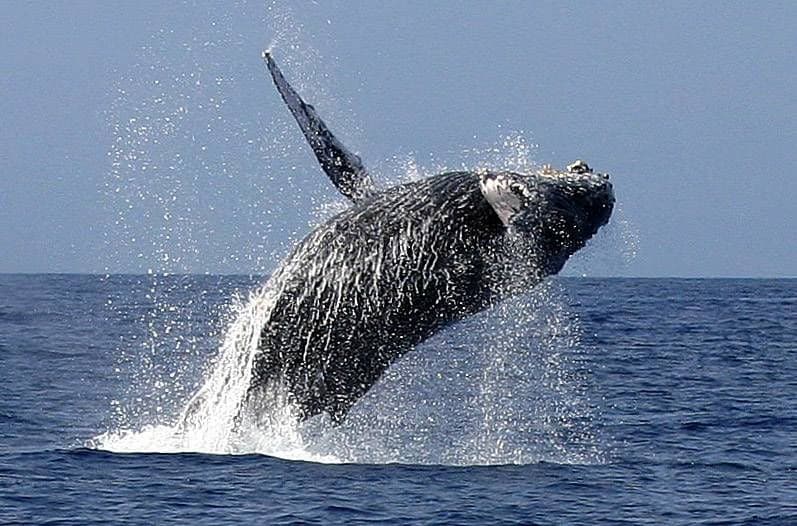
Credit - National Park Service
Best Things to do in National Park of American Samoa
Bird Watching
With over 50 different bird species living in the park at least part-time, bird watching at National Park of American Samoa is truly unlike anywhere else in the world.
There are sea birds, migrant shorebirds, and rainforest birds, and some of the most spotted species include cardinal and wattled honeyeaters and Samoan starling.
If you’re lucky, you might also spot tropical doves, pacific pigeons, petrels, or bristle thighed curlews, among many others.
Wildlife viewing
Unlike the wide variety of bird species, there are only three species of mammals that are native to the park - and they’re all bats.
The endangered flying fox - a massive fruit bat with a wingspan the size of a barn owl - is arguably the most interesting of these three species.
Also known as the giant Samoan fruit bat, these rare creatures can be seen hanging from trees rather than cave walls, so keep your eyes peeled as you wander the park if you hope to see one.
Junior Ranger Program
Completing the park’s Junior Ranger Program is a great way to get a better understanding of the area’s history, culture, biodiversity, and more.
Both kids and adults can learn a lot by completing the program, and once you’re done, you’ll receive a cool badge to commemorate your time at the park.
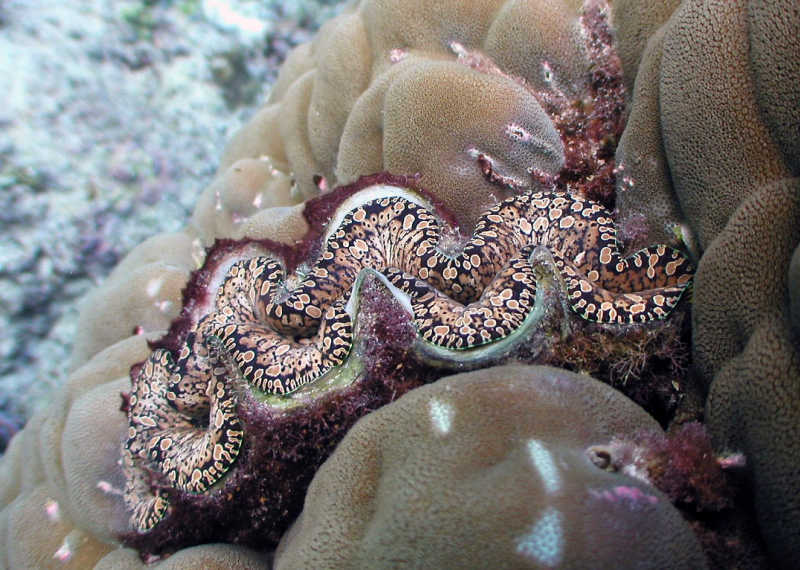
Credit - National Park Service
Snorkeling
Nearly one-third of the park’s acreage sits beneath the water, and it would be a shame to miss so much of this beautiful park!
The best way to experience the underwater parts of the park is by snorkeling, and the best area to do so is off the island of Ofu.
Here you’ll find a 350-acre coral reef teeming with 150 different species of coral and almost 300 kinds of fish swimming the crystal clear waters.
Note that you will need to bring your own snorkeling gear with you as there are no outfitters or dive centers on the island.
Of course, you could always just hang out on some of the gorgeous beaches around the park, too; be sure to cover up with a t-shirt and shorts to respect local norms and customs.
Whale Watching
Each year between August and November, southern humpback whales make their migratory journey from the Arctic.
Mothers and calves are often spotted playing just beyond the surf break, and many claim that the best spot for sighting these magnificent creatures is in Fagatele Bay - located on the southwestern side of Tutuila.
Others cite that you can see whales from virtually any place along the coast during these months, and sightings of sperm whales, porpoises, and a variety of marine turtles are also common.
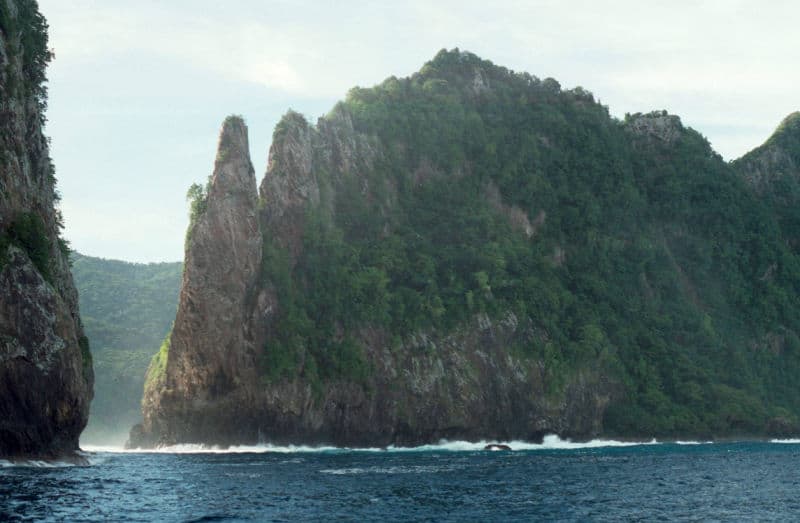
Credit - National Park Service
Hiking in National Park of American Samoa
Always carry the 10 essentials for outdoor survival when exploring.
National Park of American Samoa offers hikers the chance to traverse some seriously unique terrain during their time here, including tropical rainforests and volcanic mountains.
There are a few different options for hiking in the park, but be warned that even the “easy” trails present a bit of a challenge due to the rugged and oftentimes wet conditions.
There may also be limited signage, so be sure to ask a local or stop by the Visitor Center before heading out for the day.
Although most routes are well maintained, you may have to fight through overgrowth on some, depending on the trail and time of year.
Hikers should note that many trails lead through private property.
While it’s technically not required to ask for permission to pass, it is culturally respectful to ask for permission anyway.
Also, note that many routes are closed on Sundays.
Most trails are located on Tutuila Island, though you can find a few more rugged routes on Ofu and Ta’u as well. Check out the highlights below to learn more about some of the best trails in the park.
Lower Sauma Ridge Trail: Easy - .4 miles - Out & Back
At less than half a mile in length, this short trail offers a great “bang for your buck .”
The trailhead is located off of Route 6, just a short drive from Pago Pago on the island of Tutuila.
This is an interpretive trail, so you’ll see signage along the way depicting Samoan history, island archeology, and more.
There are also fantastic coastal views out to Pola Island on this trail, along with verdant forest scenery.
At the end, you’ll come to the Ancient Star Mount - an important archeological site.
Pola Island Trail: Easy - .6 miles - Out & Back
This is another short trail located near Pago Pago that offers coastal views out toward Pola Island.
Proper footwear is a must on this route as you will need to scramble over a rocky section of beach.
The trailhead starts at the end of a paved road in Vatia Village. Be sure to park past the last house on the road to avoid unfriendly dogs.
Oge Beach Trail: Moderate - 2.7 miles - Out & Back
For a more remote hike, head to Oge Beach Trail, located on the island of Ofu. Situated between Mata’ala Ridge and Maga Point, this stunning trail winds through a lush forest before descending on Oge Beach.
This remote coral rubble beach boasts fantastic views of Ta’u. From here you can continue walking along the coast towards Leala Point for more breathtaking vistas.
This trail is especially popular with bird watchers, so keep your eyes peeled for boobies and frigates between Mata’ala Ridge and Maga Point.
The trailhead starts at the end of the Olosega village road near the landfill.
Si’u Point Trail: Moderate - 5.4 miles - Out & Back
Following an old coastal forest road on the southeast tip of Ta’u, Si’u Point Trail offers hikers the perfect combination of beautiful scenery and absolute solitude.
The trailhead starts and the end of the main road in Fiti’uta.
You’ll know you’re on the trail once you pass the last houses and the road turns to dirt.
Mount ‘Alava Trail: Moderate - 6.1 miles - Out & Back
This is one of the longer routes in the park, leading through the tropical Samoan rainforest.
As you hike through this lush setting, you’ll pass by a banana and coconut plantation and panoramic views of the central part of Tutuila.
This trail is teeming with wildlife, and you’ll likely see some fruit bats and lots of different birds along the way.
The trailhead sits at Fagasa Pass, about three miles from Pago Pago via Route 005.
Tuafanua Trail: Hard - 1.1 miles - Out & Back
Don’t underestimate this short trail, for it’s one of the more challenging routes in the park!
Starting in the village of Vatia on the main island of Tutuila, this steep hike will take you up switchbacks through the rainforest before opening up to stunning coastal views from a hidden ridge.
From there, you will use a series of ladders and ropes to descend onto a quiet rocky beach featuring views of Pola Island.
Although it may be tempting after such a strenuous trek, hikers are advised not to enter the water here due to dangerous currents and undertows.
The trailhead begins just before the Vatia’s Mount ‘Alava Elementary School.
Tumu Mountain Trail: Hard - 5.4 miles - Out & Back
If you’re looking for a real challenge, make a beeline for Tumu Mountain Trail, located on the island of Ofu.
Although the trail is not technically part of the park, it boasts some of the best views of the area.
Hikers will journey through a tropical rainforest on their way up to the island’s highest point before reaching the lookout point at Leolo Ridge.
From here, you can take in epic views of three Manu’a islands along with the coral lagoons that line them. The trail head starts near Ofu Harbor.
How to beat the crowds in National Park of American Samoa?
National Park of American Samoa is so far off the beaten track that few really ever get to cross it off their bucket lists.
The good news is that those who do make the journey will find that they have the park mostly to themselves. So, you’re not likely to run into many other visitors, let alone crowds!
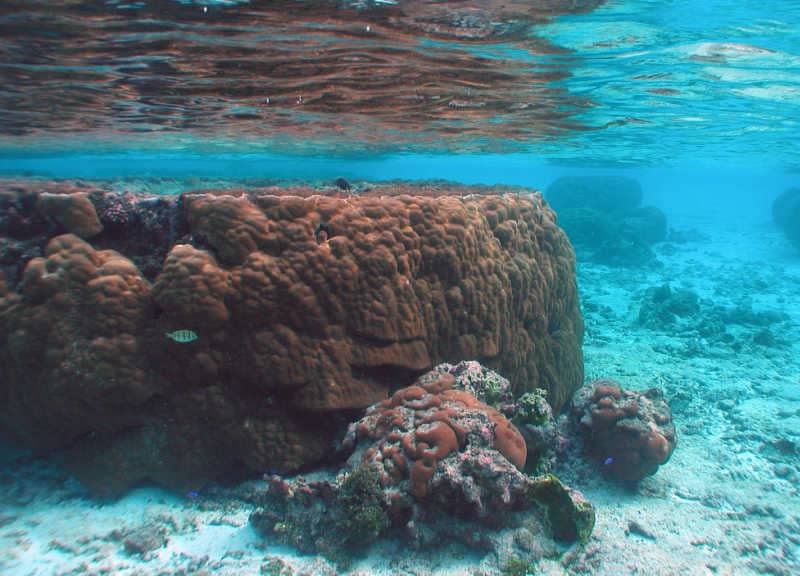
Where to stay when visiting National Park of American Samoa
There are no National Park Lodges within the park.
National Park of American Samoa is unique in the fact that the U.S. government doesn’t actually own it - they lease it from Samoans’ private land.
For this reason, there are no lodges or campgrounds in the park, but that doesn’t mean you can’t stay overnight.
Hotels
Sadies by the Sea - This hotel has a restaurant, outdoor swimming pool, and more in Pago Pago.
There are also vacation rentals available on Samoa
Camping
Camping is prohibited at National Park of American Samoa.
National Parks to visit when traveling to American Samoa
The only flight to/from American Samoa is from Honolulu, Hawaii on Hawaiian Airlines. You can also fly to Apia, Samoa, then catch a small plane to American Samoa or a once-weekly ferry service.
Pearl Harbor National Memorial
Hawai‘i Volcanoes National Park
